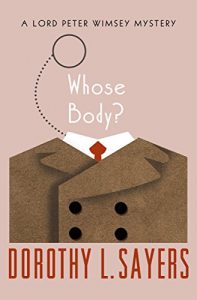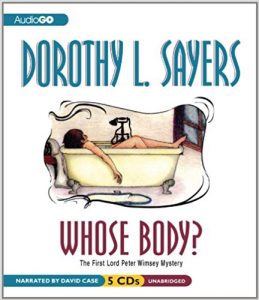Two victims. Two detectives. One body.
That’s the basic premise of the book, and I’ll be walking on very thin ice to tell you more. The story is so tightly constructed that nearly everything in it connects to a clue, and once you figure out the plot twist, you’ll never be able to forget it.
Whose Body?, published in 1923, is the first of Sayers’ 12 mystery novels featuring Lord Peter Wimsey (though Lord Peter’s first appearance was in the short story “The Attenbury Emeralds” in 1921). We get to see in depth how Lord Peter uses his hobby of detection to cope with the lingering effects of shell-shock (known to us now as PTSD) from the first World War. This case forces Lord Peter to confront his own motives and ethics. He must figure out which he holds most dear: the sanctity of human life, or the “old boy” code he learned at school? He must forge his own identity as a detective, rather than a dabbler.
We also get to know some of the best characters in the Wimsey canon: his stolid manservant Bunter (formerly Sergeant Bunter of Wimsey’s old regiment), who takes care of his schedule, his hobbies, his household and his health with a fierce loyalty. We meet Wimsey’s mother, the Dowager Duchess of Denver, who talks nonsense as glibly as Wimsey himself, all the while observing people and situations just as shrewdly. And we get to know his friend Detective Inspector Parker, the thoughtful and methodical bloodhound who provides the hard evidence to back up Wimsey’s flashes of insight. It’s Parker who pushes Wimsey to take the case seriously, and reminds him that solving murders isn’t a game, but a duty to society and to a higher truth.
It’s not just fear of spoilers that holds me back from discussing the plot. We also have to deal with a big, glaring problem in the book: it’s blended, boiled, and baked in anti-Semitism, fried in a vat of anti-Semitism, and dusted with a sprinkle of anti-Semitism on top.
The central fact of the story is that the two victims bear a superficial resemblance to each other, part of which is that they are both Jewish. Since the one body discovered at the beginning of the story is completely naked, it’s left up to a reasonably knowledgeable reader to infer that the man is circumcised. Circumcision was widely promoted in U.S. hospitals in the late 19th and 20th centuries, but it was not common practice in England except for religious reasons.
At the same time Lord Peter is called to investigate the mysterious appearance of this naked corpse, his friend Parker is investigating the disappearance of Sir Reuben Levy, a well-known financier.
Between the two cases, we manage to squarely hit every nasty Jewish stereotype in the book. It’s really quite gross.
Levy is a self-made man of humble origins, who works hard and is loyal to his friends and family, but isn’t above a bit of sharp dealing. He has secret meetings with other Jews to manipulate the financial markets for their own gain. He falls in love with and marries a beautiful Gentile heiress, much to society’s shock, and delights in showering her with expensive jewelry and other luxuries to show off his “prize.”
The corpse turns out to be a nameless vagrant, filthy and fleabitten. Literally, a “dirty Jew.” During the course of the investigation, several witnesses make various disparaging remarks about Jews in general and the victims in particular. The sympathetic characters make a great effort to be magnanimous in noting (in an condescendingly surprised way) that Jews are human beings, too, and that Levy was well-liked and had a warm, affectionate family life. The unsympathetic characters use slurs.
There’s no doubt that England was a racist place in the 1920’s. Whenever you read period fiction, you have to find a way to cope with the mindsets and language that were considered normal at the time. It’s realism, for sure. But this seems to go beyond realism to an intentional agenda.
Dorothy L. Sayers was certainly a master of her craft. She was also a woman of her time, with all the blindness and ignorance that generations have worked so hard to overcome. Of course, between this book and us there is a great divide in history — the Holocaust.
It’s interesting to note that Sayers’ last detective novel was published in 1939, and Lord Peter’s last appearance in a short story was 1942’s “Talboys.” Since the truth about the Shoah wasn’t widespread until 1942, and its full scope wasn’t revealed until the Nuremberg trials of 1945, we will never know how Sayers’ stories might have been changed by that knowledge.
On the other hand, perhaps we do — she turned away from fiction entirely and focused on theater, theology, and classical translations.
Amy Schwartz has done a fascinating, in-depth look at critiques of anti-Semitism in Sayers’ work. She has an interesting theory that Whose Body in particular is not an expression of Sayers’ own sentiment, but a product of her inner struggle against the hateful attitudes she’d absorbed from her upbringing. If the question interests you, Ms. Schwartz’s article appears in Moment magazine.
As a whodunnit, the book does a great job. The cases both seem impossible, and the various dead ends and red herrings weave themselves together into an elegant — if shocking — narrative. The characterizations of Lord Peter and his companions draw you into a rarified world, but one with humor and deep feeling.
I’d like to give Whose Body? five stars. It’s a clever puzzle well thought out and well told. But as we get farther and farther from the time period it depicts — a time when it was surprising and magnanimous to consider non-white, non-Christian people as equals — a time when even “respectable” people used racial slurs in casual conversation, with supposedly “no malice behind it”… It’s not a book I could wholeheartedly enjoy, and not one I can wholeheartedly recommend. I’m giving it three stars. Great technique, but the problems really spoiled it for me.
Whose Body? is available as a Kindle ebook, an Audible audiobook, and in many editions of paperback, hardback, and audio CD.
By request, I include a “Squick Factor” rating on reviews, to give tenderhearted readers a heads-up on graphic or disturbing material.
Sayers, as is typical for the time period, glosses over the gory details by describing the characters’ thoughts and reactions, rather than the scene at hand. There is an exhumation scene that’s handled rather wonderfully, by playing a grieving relative’s reaction to identifying the body of their beloved as a counterpoint to Lord Peter’s retreat into shell-shock. The murder plot, when finally deduced by Lord Peter, is quite a horrible idea, but it is only spoken of after the fact, in as detached a manner as possible. For gore, the story scores a 1. The real problem is the offensive language and stereotyping of the two victims, and readers who are sensitive to such issues may find it closer to a 3.
Squick Factor Range:
0 – Nil.
1 – Meh.
2 – Kinda.
3 – Oh yah, you betcha.
4 – GAAAHHH! Nuke it from space!
Browse my blog for more reviews, and sign up for my newsletter to receive monthly recommendations of free and discount books!

